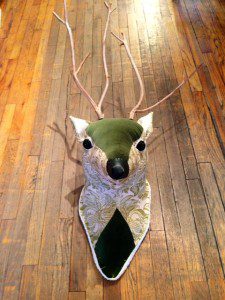
Sharon Thwing, vegetarian taxidermist, greets me at her Tucson home on a Saturday morning with the sound of little dogs yelping behind her. A petite 44-year-old woman with a gray pixie cut, dressed casually in a green T-shirt and blue jeans, she’s holding the only non-Chihuahua of the barking group. “Do you like dogs?” she asks. “This is Lizzy Lou. I’m holding her because she gets a little nippy. Just with the back of people’s heels.” Lizzy Lou is scraggly and salt-and-pepper colored, probably some sort of terrier mix. I say that of course I like dogs, even though I’ve always been a cat person.
“My instinct with animals is to form a relationship,” Sharon tells me during our interview. Her latest body of artwork is what she calls “vegetarian taxidermy,” though she won’t take credit for the name: “If you search the term online, you’ll see lots of different people use that term to describe similar artwork.” Sharon’s vegetarian taxidermy is the fabric-and-stuffing version of taxidermy animal trophies. I first saw her faux-taxidermy at a Tucson shop called Pop-Cycle, which sells handmade local art crafted from recycled materials and reused products. Sharon is drawn to making work with recycled material out of her desire to transform one thing to another.
When she first began making her vegetarian taxidermy pieces five years ago, Sharon had a pile of branches she would choose from to transform driftwood into antlers. Initially, she used to try and find the antler mates from her assorted pile. Now she tries to find the mates together from desert streams or rivers. “What I’ve learned is that when you’re looking for antlers from wood, you need to have them balance. They don’t have to be exactly the same, but they have to balance. When I’m looking for them on walks or when I’m hiking or camping, I am always on the lookout—it astounds me what nature does to wood…seems more bone-like as water works on it.” Sharon won’t find an antler’s mate from another tree because it will be a different color—won’t quite be the same thing—so she tries hard to look for a mate right away. One perfect antler without a mate almost seems to taunt her; she can make a unicorn from a single antler, but only sometimes, since unicorn horns are “very specific.”
***
I’m surprised to see very real skulls in Sharon’s living room, hung above the fireplace mantle. I count at least eleven of them artfully placed, all but the two largest cow skulls mounted on thrift-store wooden plaques. Near the skulls, a faceless vegetarian-taxidermy piece hangs, but with real animal antlers, not the driftwood kind. Underneath this particular piece, which seems to meld the worlds of fictional and nonfictional animal representation into one, is what might be described as a “vegetarian flytrap”: a piece of light blue canvas with plastic winged insects glued all over it.
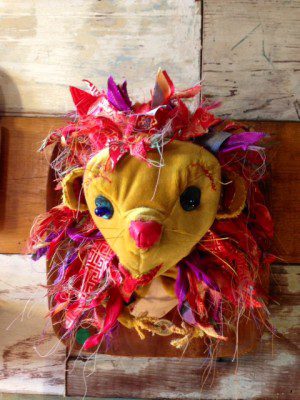
Vegetarian taxidermy is just what it sounds like: a no-animals-were-harmed replica of a trophy that usually represents some grave harm toward a nonhuman creature. Some might see Sharon’s work as art, some might see it as decoration, and some might see it as a big contradiction. I see it as all of these things, with a haunting idea lurking beneath its surface: these pieces present a pleasant and even cheerful representation of something dead. This paradoxical undercurrent is what drove me to seek out a meeting with the artist in the first place after spotting Sharon’s work at Pop-Cycle. I had been shopping for handmade local-artist postcards when I came eye-to-eye with the faux animal heads.
Sharon tells me that she has an appreciation for Mark Ryden, a painter who combines high art with low art, and pop culture with old techniques. Indeed, there are lots of his art pieces around her house, some hung on the walls, some just leaning against pieces of furniture. Ryden, like Sharon, is someone who mixes images and forms that don’t typically go together. His work, while childlike in aesthetic, almost always manages to unsettle. Sharon cites as other artistic inspirations old children’s-book illustrations of animals, woodland pictures, and anything that blends animals and people into one. She says she has no idea how to be an artist, though. She didn’t study art and only started making her work in adulthood. “When I get obsessed with something, I get obsessed, and I make, make, make all the time, and I produce huge quantities. Beads, quilts, dolls, purses.”
For Sharon, vegetarian taxidermy isn’t just work or a hobby. “I feel like when I make them, they are just kind of being manifested in the world, and I’m just one more tool,” she says. “I’m about on par with the sewing machine and the drill, because I don’t have a clear vision when I start of what it’s going to look like when I’m finished. I have some ideas, like, ‘I want these two materials together, and they’ll look good on this plaque, and these branches might look nice,’ but I don’t know what it’s going to look like.” Sharon feels like the animals she creates are almost using her to get out into the world. She doesn’t believe her creations are meant to have full bodies, which is part of why she doesn’t want them to look too realistic: “They’re not complete animals—they’re something different.”
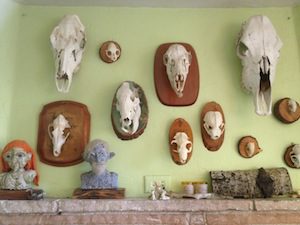 Everyone in Sharon’s immediate family is a vegetarian, but they regularly collect animal skulls. The hobby started when Sharon’s daughter, now a senior in high school, was only eight years old. The Thwing family was driving with their windows rolled down when Sharon’s husband and daughter spotted a deer skull on the side of the road. Retrieving the skull made the father-and-daughter duo so excited that it has become a tradition for the Thwing family to find a skull on every family vacation. A skull, for the Thwings, is the “best souvenir” you could ever bring home.
Everyone in Sharon’s immediate family is a vegetarian, but they regularly collect animal skulls. The hobby started when Sharon’s daughter, now a senior in high school, was only eight years old. The Thwing family was driving with their windows rolled down when Sharon’s husband and daughter spotted a deer skull on the side of the road. Retrieving the skull made the father-and-daughter duo so excited that it has become a tradition for the Thwing family to find a skull on every family vacation. A skull, for the Thwings, is the “best souvenir” you could ever bring home.
Sharon, though she’s a master at making animal skulls, says she’s terrible at finding them: “I’m not good about it at all. I never spot the skull. I never find it.” She once bought her husband a beaver skull for his birthday, but he decided it was cheating to purchase one, and now the Thwing family has a rule that all animal skulls in their home must be found.
A couple of summers ago, it occurred to the Thwings that they had been passing a treasure trove of animal skulls every time they drove past roadkill. By the end of that year’s summer vacation, they had a trash bag full of dead animals strapped to the roof of their car and a cloud of flies following them the entire way home. “It was really creepy,” Sharon admits. When they got back home, they buried the roadkill in the family backyard and waited to dig the animals up to find their treasures, their souvenirs, their skulls. Sharon values the family’s collection for its sculptural quality. She believes the skull, since it contains the brain and eyes, houses the animal’s personality and spirit as well. It resonates with her more than any other bone because it demonstrates personality so much better than a humerus or a femur.
***
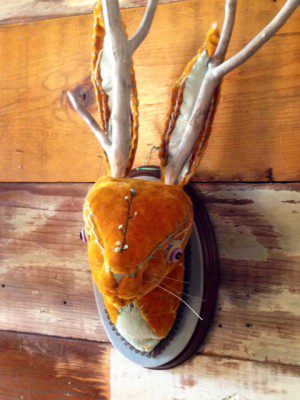
As Sharon leads me from the living room to her artist’s studio, we pass the waiting room for her vegetarian taxidermy business. These animals are waiting to be sold and shipped to customers or collectors. I see a deer made from scraps of many different materials, with antlers bigger than his head and a blue nose that matches the inside of his ears. He’s wearing what almost looks like a string of green pearls around his neck. Next to him is a jackalope with even larger antlers. Sharon recently started experimenting with removable antlers because Pop-Cycle, who works as her distributor, has found it difficult to mail the creatures to customers out of town. “This way,” she explains, “people also get to change around the direction of the antlers a bit—customize them.” The jackalope is white with black whiskers and a tuft of black hair on the top of his head. His pursed mouth makes him look like he’s sucking on a lemon as he gazes off to his right side.
Sharon says her art studio is the neatest it’s ever been. I tell her that I hope she didn’t clean it for me, and she admits that of course she cleaned it for me as I stare at a desk with vintage soup and sauce cans filled with massive quantities of scissors, pencils, and markers. The Thwing family will never go without scissors; I count at least ten pairs in this area alone. Some are in cans, and others are placed on the wall alongside hammers, hole punchers, and vintage artwork of flowers. The Thwings have a decorating principle called “the law of many”: a lot of almost anything is more interesting than one of something.
A utility lamp hangs above the desk, and I imagine Sharon working under its light at all hours of the day to build her animals. Sharon is a mother of two, a wife, and a full-time social worker. She works on her vegetarian taxidermy any chance she can get, though preferably outside during the day, because of the natural light. Afternoon light in her studio provides an ample glow as well.
For Sharon, vegetarian taxidermy is not just work. “Some stages you have to be very focused, and you have to be very present,” she says. “I love that feeling where it’s like your cerebral cortex isn’t really part of it. It’s coming from someplace else—some place out of you or some place very deep in you, and you’re just kind of observing. That’s really fun. You’re there, but you’re not really in your head. I don’t get that feeling in many other aspects of my life.”
Wall number two in Sharon’s studio is my favorite. Long hand-sewn bags of mismatched fabric hang from almost as high up as her ceiling. I know what’s in these bags, which almost look like extra-long pillows, before Sharon tells me: stuffing for her creations. I don’t peek inside, because I don’t want to see—looking inside those bags would be like seeing Sharon’s animals naked, or at least like seeing their make-believe organs. Above the pouches of stuffing are some branches. They seem too long and skinny to be used as antlers, and they’re tied together and arched in a way that makes them form a sort of twiggy rainbow over Sharon’s workspace. Sharon ties these branches together so they won’t lose their mates.
Wall number three houses a desk that, with the exception of some fabric dye, seems to be filled with inspiration rather than utility: empty cologne bottles, a tiny teacup, Swedish clogs placed on a windowsill, yarn, a plate full of coins, a vanity mirror that is missing the mirror, and the first full-bodied animal I see from Sharon’s collection. He is a small deer with a neck, torso, four legs, a tail, and the smallest antlers I have seen on any of Sharon’s creations. He is alone.
On that same wall are more branches and much more fabric. Some pieces of scrap fabric are in plastic pouches. “This is the one room in the house the dogs are not allowed into,” Sharon tells me, though she has started to use the blankets, which her dogs have partially destroyed, in her newest pieces of faux taxidermy. Blankets with dog-chewed holes are now becoming entirely new animals.
The fourth wall is almost entirely covered by a set of vintage lockers brought home by Sharon’s husband Mario. When the school he teaches at was renovating, he was able to procure Sharon a set of twenty small vintage lockers. Each one is overflowing with fabric and looks so old that I can almost smell the books and lunches they once held. Above the lockers are vintage needlepoint pieces of birds and a few rabbits. I see one landscape painting, almost as lonely as the full-bodied deer nearby.
The way that Sharon’s husband saves physical objects from being thrown out is the way he wants to save his own body after his death. “My husband very very much wants to, when he dies, wants to be able to give his skeleton to our children. It’s kind of a joke, but he spends a lot of time talking to people about how he legally could go about doing this. I would not want his skeleton, his skull. I think that would be too much. But the kids would probably fight over his skull.”
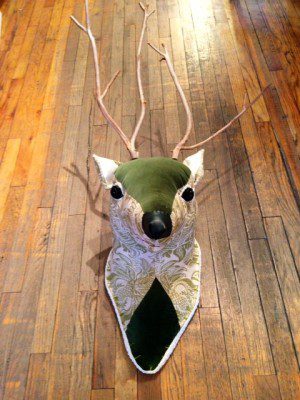
Sharon’s husband also saved the 1960s oversized flashcards which now comprise the family’s kitchen wallpaper. I see a gold watch, a collie dog, an acoustic guitar, a white roller skate, a 1960s cartoon vision of a robot, a female teacher next to a chalkboard, red Jell-O, a 4-track tape player, an apple, a television, an airplane, a stop sign, crackers, a peach, a boy, a mountain, the number 5, a gun, a postal worker, and a glass of milk. “We’re not done hanging them up, and I’m just ready to be done with this project,” says Sharon. The flash cards look great, but she seems exhausted from re-using materials in this area of her life—the kitchen. “When I get into something, I’m insane,” she says. “I just am.” It took an entire summer to cover one wall with these cards, and there are more still to go.
I turn my head and see more cards-as-wallpaper: bread, a horse, a helicopter, a swan, a sad-looking little girl with a bowtie, a bicycle, a man on a tractor, a drum set, a house, a child playing hopscotch, a pear, a Volkswagen Bug, eggs sunny-side up, a kangaroo, an astronaut, a deer, a rotary phone, a pineapple. Sharon says her family will be back soon and suggests we go somewhere quiet to discuss her work. The little dogs have stopped yelping, and the house is loud only visually.
At a coffee shop a few blocks from her home, Sharon reveals to me that she got the idea to try faux-taxidermy from Stuffed magazine (tagline: “A Gathering of Softies”). In one issue, Sharon saw a faux-fish trophy and was inspired. That, and the fact that driftwood had always looked like antlers to her, caused Sharon to take her first leap into vegetarian taxidermy. Using a cummerbund and an old sequined sweater, Sharon created her first animal: a fish.
Still, Sharon considers her first completed piece in the collection to be a ram named Winslow she put together by hand before she knew how to use a sewing machine. Winslow took “forever-forever” to make and was the only animal for whom she ordered glass taxidermy eyes. She decided to let Winslow be a one-off piece, because his glass eyes were too expensive and, due to their realism, made her uncomfortable. He now lives over her and her husband’s bed.
***
Sharon was born and raised in Anchorage, Alaska, where taxidermy was a common decorating theme. She finds it hilarious that her father had taxidermy around his home, considering he wasn’t a hunter. Sharon has been a vegetarian for twenty-three years but has always been drawn to taxidermy and sometimes has to stop herself from buying it at thrift stores and swap meets. Instead, she 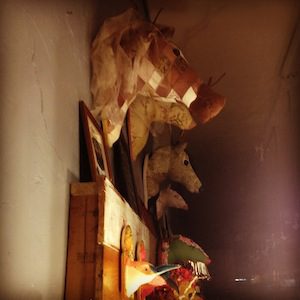 collects skulls. “My youngest son would kill me,” she says. “Taxidermy would not be allowed in the house. I’m a little torn. I don’t have a strong feeling on taxidermy because aesthetically I love it. But then if I think about the fact that it was a living animal and this has happened to it, I feel bad.”
collects skulls. “My youngest son would kill me,” she says. “Taxidermy would not be allowed in the house. I’m a little torn. I don’t have a strong feeling on taxidermy because aesthetically I love it. But then if I think about the fact that it was a living animal and this has happened to it, I feel bad.”
Sharon sees taxidermy as a safe way to make a connection and to learn about animals that could never be household pets. “I’m always surprised at how huge these animals are, how big deer really are,” she says. “I think that some of my deer heads are so big, but they’re nothing close to the real thing. And a buffalo—they’re ginormous. And then to look at how strange their heads are, and their bone structure. I can never get the bone structure to show through in my animals and where their eyes are placed. With taxidermy, you can look so close and see those details. But then if you let yourself think deeper, taxidermy becomes a testament to ‘I conquered this. I vanquished this animal, and now it’s captive in my house.’”
Sharon spends a lot of time studying an animal’s face before she starts creating her art pieces. While she reuses material, she still doesn’t feel like she makes the most efficient use of fabric due to her pickiness about placement of patterns or material. She also hesitates to describe herself as a careful tracer or cutter. She’s “not very precise,” and she often loses her own patterns and has to start from scratch. Often, while she’s making her creatures, her hands get cut up by chicken wire and covered in scratches. She wrestles with her animals to get them made—or they wrestle with her to become alive. She says it takes a lot of physical strength to hold her animals down to insert just the right amount of stuffing to make them look like they “really are alive.”
***
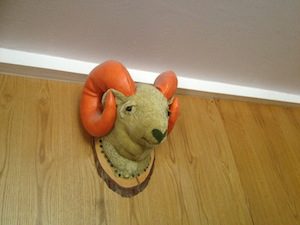 After coffee, we go back to Sharon’s house, and I’m allowed into her bedroom to see her first piece of vegetarian taxidermy. Winslow the ram does look more realistic than her other pieces, even with his orange horns. His glass eyes look somber, and his fur is so authentic-looking that he seems almost uncomfortable pinned to his wooden backing. Winslow is positioned higher up on the wall than any of the other vegetarian taxidermy pieces in Sharon’s home. His nose looks a bit like a heart.
After coffee, we go back to Sharon’s house, and I’m allowed into her bedroom to see her first piece of vegetarian taxidermy. Winslow the ram does look more realistic than her other pieces, even with his orange horns. His glass eyes look somber, and his fur is so authentic-looking that he seems almost uncomfortable pinned to his wooden backing. Winslow is positioned higher up on the wall than any of the other vegetarian taxidermy pieces in Sharon’s home. His nose looks a bit like a heart.
On one wall of Sharon’s bedroom, I notice an overflow of vegetarian taxidermy. A deer-giraffe hybrid is the most psychedelically colored of all the pieces—he’s made of fabric with birds all over it, and he’s attached to a painting of a landscape as if he were sticking out of nature quite literally. But my favorite is the pink hedgehog. I love the way his quills look like leaves from sort of succulent plant. He even has two tiny arms that seem to almost sneak into the trophy. Next to him is a white unicorn complete with single horn—the exception to the antlers-needing-the-right-mate rule. My eyes go back to the hedgehog, and now I notice he’s sticking his tongue out. None of the other animals do anything like this. I might actually buy this hedgehog to keep on my own wall. “I feel like this is art that you can form a relationship with,” says Sharon, “and that’s my hope—that people will have a relationship with it. It won’t be something that’s decoration in their house. They’ll ascribe some personality to it, they’ll talk to it, and a relationship will develop.”
In the future, Sharon sees herself making more three-dimensional landscapes, almost like “adult playthings.” She recently created a little wolf and trees on an old piece of wood. She would like to make more whole-bodied animals in the future as well, but is worried that people would think they are toys and then her animals would be in harm’s way. As trophies, her animals live high up on the wall, safe from hands and safe from harm.
On my way out, I see a pencil drawing of one of the little yelping dogs, Heidi, from two different angles. Sharon’s son has drawn both a profile and a full-body view of the Chihuahua mix, who only recently joined the family. In bubble letters, the drawing says, “Season of the Heidi.” Sharon had said no to bringing any new pets into the household, but then Heidi wandered in and bonded with her son, who has now been bitten by the artist bug. The Thwings are artists. Their home is practically an installation. As I walk out the door, I marvel at them waving good-bye to me, standing side by side the way most families only do when they are posing for a picture.
***
Listen to Cathy read her essay:




